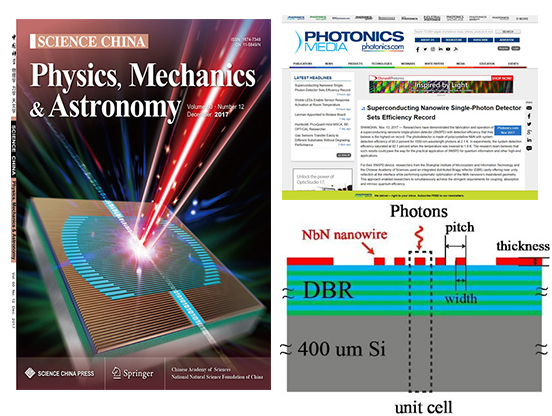Practical Superconducting Nanowire Single-Photon Detector Sets Efficiency Record
Date:05-12-2017 | 【Print】 【close】
Researchers have demonstrated the fabrication and operation of a superconducting nanowire single-photon detector (SNSPD) with detection efficiency that they believe is the highest on record. The photodetector is made of polycrystalline NbN with system detection efficiency of 90.2 percent for 1550-nm-wavelength photons at 2.1 K. In experiments, the system detection efficiency saturated at 92.1 percent when the temperature was lowered to 1.8 K. The research team believes that such results could pave the way for the practical application of SNSPD for quantum information and other high-end applications.
For their SNSPD device, researchers from the Shanghai Institute of Microsystem and Information Technology and the Chinese Academy of Sciences used an integrated distributed Bragg reflector (DBR) cavity offering near unity reflection at the interface while performing systematic optimization of the NbN nanowire’s meandered geometry. This approach enabled researchers to simultaneously achieve the stringent requirements for coupling, absorption and intrinsic quantum efficiency.
The device exhibited timing jitters down to 79 picoseconds (ps), almost half that of previously reported WSi-SNSPD, promising additional advantages in applications requiring high timing precision.
According to researchers, the record for the best system detection efficiency at an incident photon wavelength of 1550 nm is 93 percent — attained from a superconducting nanowire single-photon detector made of amorphous tungsten-silicide (WSi). Such detectors are usually operated at sub-K temperatures and require expensive refrigeration equipment.
Extensive efforts have been made to develop SNSPDs based on NbN, targeted at operating temperatures above 2 K, which are accessible with a compact, user-friendly cryocooler. Achieving a detection efficiency of more than 90 percent has required the simultaneous optimization of many different factors, including near perfect optical coupling, near perfect absorption and near unity intrinsic quantum efficiency.
The device has been applied to the quantum information frontier experiments at the University of Science and Technology of China.
SNSPD with near unity detection efficiency and the ability to operate on an economical and user-friendly compact cryocooler could provide scientists with a powerful and easy to access tool. The research team believes that further breakthroughs in optical quantum computation and simulation and quantum key distribution could be made possible using their device. The team has founded a startup company, Shanghai Photon Technology Co. Ltd., to commercialize the technology.
The research was published in
